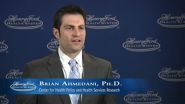(Press-News.org) A new paper to be published in the journal Zootaxa (April 6, 2015) describes 30 new insect species in a single genus, Megaselia, of the fly family Phoridae. Describing 30 species in a single paper is rare, but what's especially striking is that all these come from urban Los Angeles.
The discoveries come from researchers in the BioSCAN project (Biodiversity Science: City and Nature) at the Natural History Museum of Los Angeles County (NHM). The BioSCAN project is a three year investigation of patterns of biodiversity in and around urban Los Angeles, based on sampling the world's most diverse fauna: insects. Local residents participate in the study by hosting one of the 30 sampling sites, each of which has a continuously operating insect trap and a microclimate weather station. Every household's set of samples yielded at least one of the 30 new species, prompting the researchers to name each species after the resident in whose back yard the species was found.
The project is yielding an unprecedented biodiversity collection, consistently accumulated across space and through time, curated for permanent research availability at NHM. Lead author Emily Hartop, an entomologist at NHM, examined over 10,000 specimens of phorid flies from three months of the samples to find these 30 new species. This result clearly demonstrates the extraordinary level of biodiversity that remains to be discovered even in heavily human-influenced areas.
Most people in the world now live in cities, and the ecology of those cities is an increasingly important focus for academic and museum researchers. Urban biodiversity is immediately important to humans -- urban ecosystems deliver ecosystem services critical for human survival right where people live. The public and, it must be admitted, the research community, have long assumed that biodiversity discoveries happen only in exotic, undisturbed locales. That turns out not to be the case.
Dr. Brian Brown, Curator of Entomology at NHM and principal investigator of BioSCAN, has extensive experience exploring and discovering insect biodiversity in tropical areas like Costa Rica. Goaded by a bet with an NHM trustee, he set out to prove that he could discover a new species in a Los Angeles backyard. When the very first specimen he examined from a trap in that urban backyard turned out to be a new species, Dr. Brown was inspired to pursue a deeper investigation of Los Angeles urban biodiversity, leading to the BioSCAN project. "I always thought we had the potential to discover new species wherever we sample -- urban, tropical, anywhere. But 30 new species from a heavily urbanized area is really astounding," Dr. Brown said.
To plan for an urban future that incorporates a fully functioning support ecosystem, we need to know how to manage urban biodiversity. To do that, we need studies like BioSCAN to help us understand just how urbanization a?ects biodiversity. Emily Hartop, lead author on the paper describing the new species, is excited by the implications of this seemingly simple result: "Right now we're finding out what's here -- and it's more than we ever expected. By linking these biodiversity results with the physical data we're collecting at these sites, we'll be able to contribute directly to the policy discussion of how best to plan and manage urban biodiversity."
More details on Emily Hartop's journey to 30 new species can be found at the BioSCAN post on "How I Discovered 30 New Species of Flies in Los Angeles": http://research.nhm.org/bioscan/bioscanbuzz/?p=706
For further information on why studying urban biodiversity is so important today, see the posting "Why bother with urban biodiversity?": http://research.nhm.org/bioscan/bioscanbuzz/?p=668
A key component of the BioSCAN project has been the enthusiastic support of the urban sampling site hosts. Biologists, used to being able to sample fairly freely in undeveloped areas, find themselves stymied by private property restrictions in urban settings. But the eagerness of Angelenos to help the project has turned that "problem" into an advantage. Not only are the researchers getting the long-term sampling sites they need, urban residents are now part of the research enterprise.
Site host Walter Renwick said: "For us, it seemed like a no-brainer. We have two young bug-crazy children, a bug-crazy dad, and very patient mom in our household. We have ample space in our backyard and plan to stay in our home for at least another 3 years, if not longer. Even so, we were still a bit shy to commit, but with one visit from NHM staff, a mock-up of the trap, and we were sold!"
These site hosts are making it possible for BioSCAN to achieve its sampling goals, making the discovery of these30 species possible. In recognition of that, each species is named in honor of the hosts of the site where it was found.
INFORMATION:
About the Natural History Museum
The Natural History Museum of Los Angeles County is a national leader in research, exhibitions and education. The Museum was the first dedicated museum building in Los Angeles, opening its doors in 1913. It has amassed one of the world's most extensive and valuable collections of natural and cultural history -- with more than 35 million objects, some as old as 4.5 billion years. For more information, visit the Museum's website at http://www.nhm.org or call (213) 763-DINO.
AUBURN, AL - In the production of organic vegetables, nitrogen is important, yet can be quite costly to manage. Nitrogen management is even more challenging when production practices call for the use of polyethylene mulch combined with fertigation. The authors of a new study published in HortScience have found that hydrolyzed fish fertilizer holds promise as an "economically feasible" nitrogen source for growing organic vegetables.
"Soluble organic nitrogen sources suitable for fertigation in organic vegetable production are much needed," said lead author of the study, ...
(SACRAMENTO, Calif.) -- In an editorial posted online today in the Annals of Emergency Medicine, two practicing emergency medicine physicians from the University of California, Davis, and Brown University -- both thought leaders at the forefront of finding solutions to the public health crisis of gun violence -- urge their colleagues to take direct action to protect the health and safety of patients and communities.
Their editorial follows the Feb. 24 call to action by eight health professional organizations, including the American College of Emergency Physicians, and ...
In the year since the World Health Organization (WHO) was first notified of an outbreak of what proved to be Ebola virus disease in the west African country of Guinea, more than 24,000 cases have been reported and over 10,000 individuals have died - primarily in Guinea, Liberia and Sierra Leone. Moreover, countless non-Ebola deaths have occurred as a result of the closing of health systems in those countries, and an international aid effort has invested billions of dollars in control efforts.
In a paper published in the open-access journal PLOS Medicine, experts in ...
NASA-NOAA's Suomi NPP satellite captured an image of the remnants of Tropical Cyclone Nathan over the southern Top End of Australia's Northern Territory on March 25.
On March 25, the Australian Bureau of Meteorology (ABM) issued a Severe Weather Warning for heavy rainfall for people in the Daly, Arnhem, Carpentaria and Gregory forecast districts of Top End. The Top End contains the region's capital city of Darwin, and is home to Kakadu National Park, the country's largest national park. For updated watches and warnings, visit: http://www.bom.gov.au/cyclone/.
When Suomi ...
Getting a good education may not improve your life chances of happiness, according to new mental health research from the University of Warwick.
In a new study published in the British Journal of Psychiatry, researchers from Warwick Medical School examined socioeconomic factors related to high mental wellbeing, such as level of education and personal finances.
Low educational attainment is strongly associated with mental illness but the research team wanted to find out if higher educational attainment is linked with mental wellbeing.
The team found all levels of ...
Mobile devices have a large number of different adjustable system settings whose energy impact can be difficult to understand for the average user, and even for the expert.
Some system settings have a direct and significant correlation with energy consumption, for example screen brightness and network connectivity. The energy impact of system settings and their combinations, such as the combination of roaming, high operating temperature, and bad signal strength, are much more difficult to predict. The research article by the Finnish computer scientists demonstrates that ...
An analysis conducted by researchers at the Johns Hopkins Center for a Livable Future (CLF) found that the risks of drinking raw (unpasteurized) cow's milk are significant. Consumers are nearly 100 times more likely to get foodborne illness from drinking raw milk than they are from drinking pasteurized milk. In fact, the researchers determined that raw milk was associated with over half of all milk-related foodborne illness, even though only an estimated 3.5% of the U.S. population consumes raw milk.
Based on their findings, the researchers discourage the consumption ...
DETROIT - Co-existing psychiatric illness should be considered in assessing hospital readmissions for three common medical conditions used by Medicare and Medicaid to penalize hospitals with "excessive" readmission rates.
That was the conclusion of a newly published collaborative study by 11 major U.S. healthcare providers - including Henry Ford Health System - affiliated with the nationwide Mental Health Research Network (MHRN).
The study is published in Psychiatric Services.
The subject of readmission rates has been of increasing concern to U.S. hospitals since ...
Scientists at Columbia University's Mailman School of Public Health report that children with autism spectrum disorder (ASD) were two-and-a-half times more likely to have persistent gastrointestinal (GI) symptoms as infants and toddlers than children with typical development. Results are published in JAMA Psychiatry.
The study is based on a large longitudinal survey of Norwegian mothers who were asked about their child's GI disturbances during the first three years of life. Questionnaires were completed when the children were 18 and 36 months of age.
The authors ...
Gastrointestinal symptoms reported by mothers were more common and more often persistent in the first three years of life in children with autism spectrum disorder than in children with typical development and developmental delay, according to an article published online by JAMA Psychiatry.
Autism spectrum disorders (ASDs) are characterized by problems in social communication and interaction, as well as restricted/repetitive behaviors. Medical and psychiatric conditions are frequently associated with ASD and among the most common are gastrointestinal (GI) symptoms and ...



